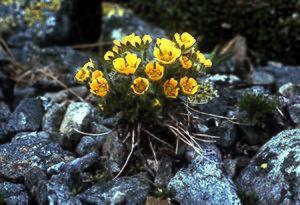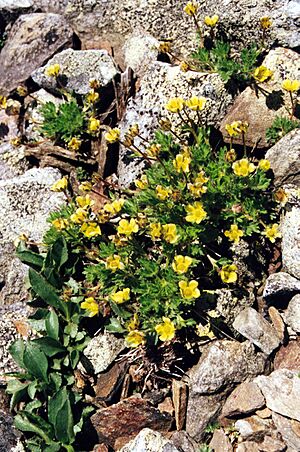Dwarf mountain cinquefoil facts for kids
Quick facts for kids Dwarf mountain cinquefoil |
|
|---|---|
 |
|
| Robbins' cinquefoil (Potentilla robbinsiana) |
|
| Scientific classification | |
| Genus: |
Potentilla
|
| Species: |
robbinsiana
|
Potentilla robbinsiana, also known as the dwarf mountain cinquefoil or Robbins' cinquefoil, is a tiny plant with yellow flowers. It is a perennial, meaning it lives for more than two years. You can only find this special plant high up in the White Mountains of New Hampshire. It grows above the tree line, where no trees can grow. This plant is very small, usually only two to four centimeters wide, and has almost no stem.
Contents
The Story of Robbins' Cinquefoil
The Crawford Path on Mount Washington, America's oldest mountain hiking trail, was built in 1819. It was first used as a path for horses. People are not completely sure who first found Potentilla robbinsiana. Some say it was the English botanist Thomas Nuttall in 1824. But it is more likely that James Robbins discovered it in 1829.
Soon after its discovery, William Oakes, another botanist, described the plant. People quickly realized it was very rare. Over 850 plant samples were collected. Some were even sold to collectors and museums.
Saving a Special Plant
In the 1970s, more and more people started hiking. This led to a "backpacker boom" on the Crawford Path. The plant's small home became very vulnerable. Hikers sometimes picked the flowers or accidentally stepped on the plants. This caused the number of Potentilla robbinsiana to drop.
To protect the plant, it was listed under the Endangered Species Act in 1980. At that time, only about 3,700 plants were left. But thanks to a very successful plan, the plant made a great comeback!
This plan included several important steps:
- Awareness Programs: People learned about the plant and why it needed protection.
- Trail Rerouting: Hiking trails were moved away from where the plants grew.
- Protective Fences: Fences were put around the main groups of plants.
- Public Education: People were taught how to protect the plant.
- Research: Scientists studied the plant to learn more about it.
- Seed Collection: Seeds were gathered to help grow new plants.
- Transplanting: Some plants were moved to new, safe areas.
Because of these efforts, the number of plants grew to over 14,000. In August 2002, the plant was no longer considered endangered.
Working Together for Nature
The success in saving Potentilla robbinsiana happened because many groups worked together. These groups included the U.S. Fish & Wildlife Service, the Appalachian Mountain Club, the U.S. Forest Service, and the New England Wild Flower Society. Their teamwork showed how much can be achieved when people work together to protect nature.
Where Robbins' Cinquefoil Lives
The dwarf mountain cinquefoil is very special because it only lives in one place in the world. All of its known population is found within the White Mountain National Forest. There are four places where the plant currently grows. Two of these are natural areas, and the other two are places where plants were moved to help them grow.
What Kind of Home Does it Need?
Potentilla robbinsiana usually lives in dry, open areas high in the mountains. These places are called alpine communities. You can also find it on bare, rocky mountain tops below the highest peaks. Its main home is a windy, cold, and rocky area called a fellfield. The ground in these areas often freezes and thaws, which helps the plant. However, too much freezing and thawing can harm the plant.


